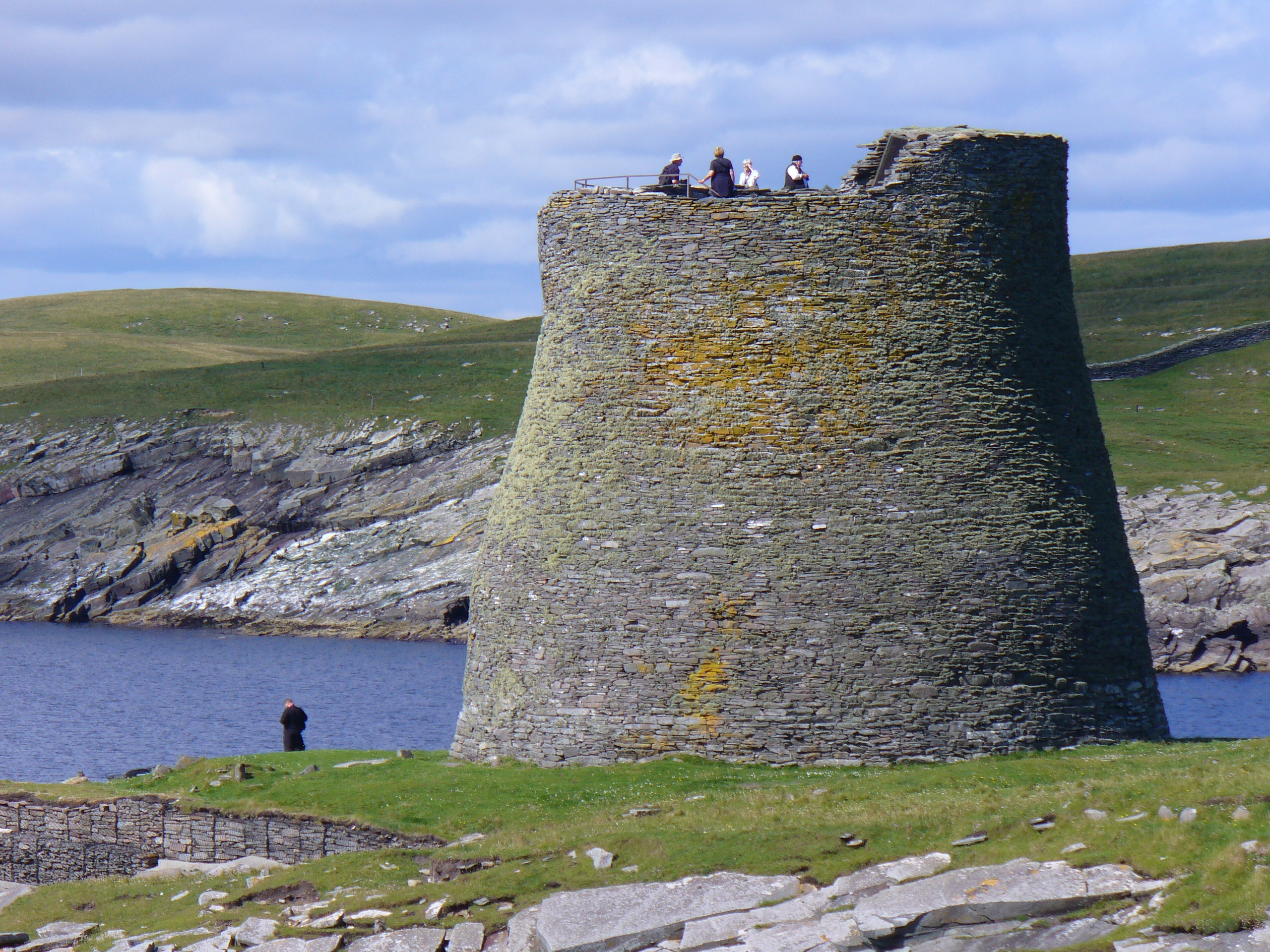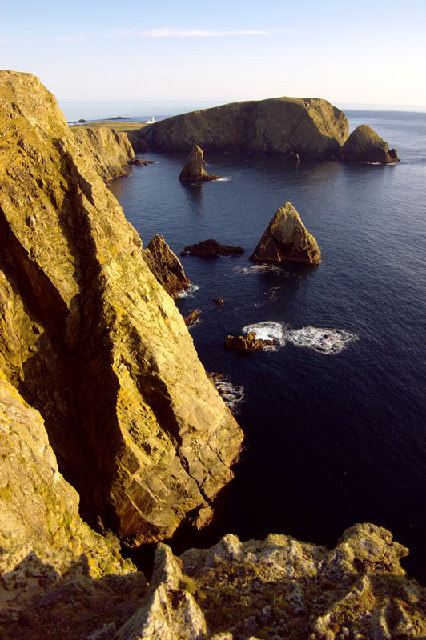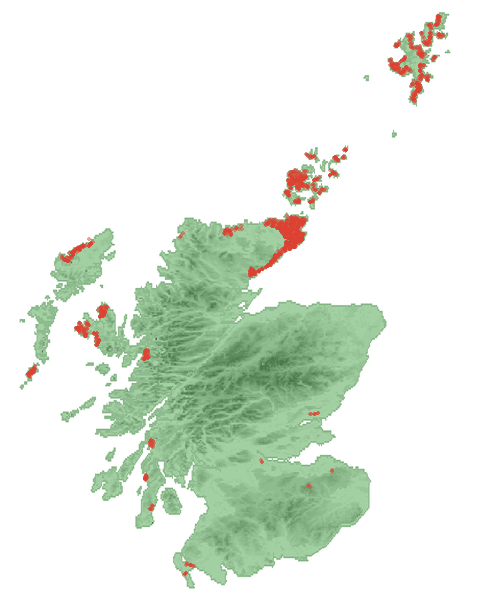|
Broch Of Culswick
The Broch of Culswick (also Culswick Broch) is an unexcavated coastal broch in the Shetland Islands of Scotland (). It has good views all around, including Foula and Vaila isles, and Fitful Head and Fair Isle in the south. The broch stands on the top of a rock platform and is about 3 metres high at its tallest point. Much rubble has fallen into the centre. This broch has a massive triangular lintel stone over the entrance, which is partly filled with rubble. Drawings by Low in 1774 and Skene in 1805 reveal that the structure survived very well up to those dates. Location The Broch of Culswick is located a kilometre west of Culswick in the parish of Sandsting Sandsting is a parish in the West Mainland of Shetland, Scotland, forming a southern arm of the Walls Peninsula. After the parish of Aithsting was annexed into Sandsting in the sixteenth century, it became known as Sandsting and Aithsting pari .... It is on top of a steep, smooth knoll near cliffs and the sea. De ... [...More Info...] [...Related Items...] OR: [Wikipedia] [Google] [Baidu] |
Mainland, Shetland
The Mainland is the main island of Shetland, Scotland. The island contains Shetland's only burgh, Lerwick, and is the centre of Shetland's ferry and air connections. Geography It has an area of , making it the third-largest Scottish island and the fifth largest of the British Isles after Great Britain, Ireland, Lewis and Harris and Skye. Mainland is the second most populous of the Scottish islands (only surpassed by Lewis and Harris), and had 18,765 residents in 2011 compared to 17,550 in 2001. The mainland can be broadly divided into four sections: *The long southern peninsula, south of Lerwick, has a mixture of moorland and farmland and contains many important archaeological sites. **Bigton, Cunningsburgh, Sandwick, Scalloway, and Sumburgh *The Central Mainland has more farmland and some woodland plantations. *The West Mainland **Aith, Walls, and Sandness *The North Mainland – in particular the large Northmavine peninsula, connected to Mainland by a narrow isthmus at ... [...More Info...] [...Related Items...] OR: [Wikipedia] [Google] [Baidu] |
Broch
A broch is an Iron Age drystone hollow-walled structure found in Scotland. Brochs belong to the classification "complex Atlantic roundhouse" devised by Scottish archaeologists in the 1980s. Their origin is a matter of some controversy. Origin and definition The word ''broch'' is derived from Lowland Scots 'brough', meaning (among other things) fort. In the mid-19th century Scottish antiquaries called brochs 'burgs', after Old Norse ', with the same meaning. Place names in Scandinavian Scotland such as Burgawater and Burgan show that Old Norse ' is the older word used for these structures in the north. Brochs are often referred to as ''duns'' in the west. Antiquarians began to use the spelling ''broch'' in the 1870s. A precise definition for the word has proved elusive. Brochs are the most spectacular of a complex class of roundhouse buildings found throughout Atlantic Scotland. The Shetland Amenity Trust lists about 120 sites in Shetland as candidate brochs, while the Royal C ... [...More Info...] [...Related Items...] OR: [Wikipedia] [Google] [Baidu] |
British Iron Age
The British Iron Age is a conventional name used in the archaeology of Great Britain, referring to the prehistoric and protohistoric phases of the Iron Age culture of the main island and the smaller islands, typically excluding prehistoric Ireland, which had an independent Iron Age culture of its own. The parallel phase of Irish archaeology is termed the Irish Iron Age. The Iron Age is not an archaeological horizon of common artefacts but is rather a locally-diverse cultural phase. The British Iron Age followed the British Bronze Age and lasted in theory from the first significant use of iron for tools and weapons in Britain to the Romanisation of the southern half of the island. The Romanised culture is termed Roman Britain and is considered to supplant the British Iron Age. The tribes living in Britain during this time are often popularly considered to be part of a broadly-Celtic culture, but in recent years, that has been disputed. At a minimum, "Celtic" is a linguistic ter ... [...More Info...] [...Related Items...] OR: [Wikipedia] [Google] [Baidu] |
Broch
A broch is an Iron Age drystone hollow-walled structure found in Scotland. Brochs belong to the classification "complex Atlantic roundhouse" devised by Scottish archaeologists in the 1980s. Their origin is a matter of some controversy. Origin and definition The word ''broch'' is derived from Lowland Scots 'brough', meaning (among other things) fort. In the mid-19th century Scottish antiquaries called brochs 'burgs', after Old Norse ', with the same meaning. Place names in Scandinavian Scotland such as Burgawater and Burgan show that Old Norse ' is the older word used for these structures in the north. Brochs are often referred to as ''duns'' in the west. Antiquarians began to use the spelling ''broch'' in the 1870s. A precise definition for the word has proved elusive. Brochs are the most spectacular of a complex class of roundhouse buildings found throughout Atlantic Scotland. The Shetland Amenity Trust lists about 120 sites in Shetland as candidate brochs, while the Royal C ... [...More Info...] [...Related Items...] OR: [Wikipedia] [Google] [Baidu] |
Shetland Islands
Shetland, also called the Shetland Islands and formerly Zetland, is a subarctic archipelago in Scotland lying between Orkney, the Faroe Islands and Norway. It is the northernmost region of the United Kingdom. The islands lie about to the northeast of Orkney, from mainland Scotland and west of Norway. They form part of the border between the Atlantic Ocean to the west and the North Sea to the east. Their total area is ,Shetland Islands Council (2012) p. 4 and the population totalled 22,920 in 2019. The islands comprise the Shetland constituency of the Scottish Parliament. The local authority, the Shetland Islands Council, is one of the 32 council areas of Scotland. The islands' administrative centre and only burgh is Lerwick, which has been the capital of Shetland since 1708, before which time the capital was Scalloway. The archipelago has an oceanic climate, complex geology, rugged coastline, and many low, rolling hills. The largest island, known as " the Mainland", ha ... [...More Info...] [...Related Items...] OR: [Wikipedia] [Google] [Baidu] |
Foula
Foula (; sco, also Foola; nrn, Fuglø), located in the Shetland archipelago of Scotland, is one of the United Kingdom’s most remote permanently inhabited islands. Owned since the turn of the 20th century by the Holbourn family, the island was the location for the film ''The Edge of the World'' (1937). The liner RMS ''Oceanic'' was wrecked on the nearby Shaalds of Foula in 1914. Toponym The name "Foula" derives from Old Norse ''Fugley'', "bird island": compare the Faroese name of the island of Fugloy, "bird island", and Scottish Gaelic ''Fughlaigh''. Geography Foula lies in the Atlantic Ocean, west of Walls in Shetland. It was part of Walls civil parish. The island is about , with a low-lying coastal strip along the east side. With an area of , it is the seventh largest and most westerly of the Shetland Islands. It rises from low broken cliffs in the east to precipitous cliffs in the west. The island has five peaks, rising to at the Sneug and at the Kame. At the north e ... [...More Info...] [...Related Items...] OR: [Wikipedia] [Google] [Baidu] |
Vaila
Vaila (Old Norse: "Valey") is an island in Shetland, Scotland, lying south of the Westland peninsula of the Shetland Mainland. It has an area of , and is at its highest point.Haswell-Smith, Hamish. (2004) The Scottish Islands. Edinburgh. Canongate. Vaila is home to an organic sheep farm and is also known for its mountain hares. In 2022, the island was put up for sale at £1.75 million History The island has been inhabited for thousands of years, and Neolithic and Bronze Age remains have been found there. Other remains on the island include Mucklaberry Castle tower, which was restored in the 1890s. In 1490, the Ciske family's estates were divided and Vaila and Foula became the property of Alv Knutsson. However, the Ciskes were Norwegian, and as Scotland had annexed Shetland a few decades before, there were confusing and conflicting claims of ownership. In the 17th century Martin Martin recorded an unusual folk tale: The inhabitants of the isle Vaila say that no cat will l ... [...More Info...] [...Related Items...] OR: [Wikipedia] [Google] [Baidu] |
Fair Isle
Fair Isle (; sco, Fair Isle; non, Friðarey; gd, Fara) is an island in Shetland, in northern Scotland. It lies about halfway between mainland Shetland and Orkney. It is known for its bird observatory and a traditional style of knitting. The island has been owned by the National Trust for Scotland since 1954. Geography the most remote inhabited island in the United Kingdom. It is administratively part of the parish of Dunrossness, Shetland, and is roughly equidistant from Sumburgh Head, some to the northeast on the Mainland of Shetland and North Ronaldsay, Orkney, some to the southwest. Fair Isle is long and wide. It has an area of , making it the tenth-largest of the Shetland Islands. It gives its name to one of the British Sea Areas. Most of the islanders live in the crofts on the southern half of the island, the northern half consisting of rocky moorland. The western coast consists of cliffs of up to in height, Ward Hill at being the highest point of the islan ... [...More Info...] [...Related Items...] OR: [Wikipedia] [Google] [Baidu] |
Culswick
The Broch of Culswick (also Culswick Broch) is an unexcavated coastal broch in the Shetland Islands of Scotland (). It has good views all around, including Foula and Vaila isles, and Fitful Head and Fair Isle in the south. The broch stands on the top of a rock platform and is about 3 metres high at its tallest point. Much rubble has fallen into the centre. This broch has a massive triangular lintel stone over the entrance, which is partly filled with rubble. Drawings by Low in 1774 and Skene in 1805 reveal that the structure survived very well up to those dates. Location The Broch of Culswick is located a kilometre west of Culswick in the parish of Sandsting Sandsting is a parish in the West Mainland of Shetland, Scotland, forming a southern arm of the Walls Peninsula. After the parish of Aithsting was annexed into Sandsting in the sixteenth century, it became known as Sandsting and Aithsting pari .... It is on top of a steep, smooth knoll near cliffs and the sea. De ... [...More Info...] [...Related Items...] OR: [Wikipedia] [Google] [Baidu] |
Sandsting
Sandsting is a parish in the West Mainland of Shetland, Scotland, forming a southern arm of the Walls Peninsula. After the parish of Aithsting was annexed into Sandsting in the sixteenth century, it became known as Sandsting and Aithsting parish. Summary The parish includes the settlements of Skeld, Westerwick and Culswick. It contains the islands of Vementry and Papa Little together with a number of smaller islets, on the south side of St Magnus Bay, and comprehends a mainland district of about ten miles by eight between that bay and Scalloway Bay. The coast is partly bold, and cavernous; the seaboard is cut into sections by long bays; and the interior is mostly an assemblage of knolls and hillocks, with a profusion of heath and interspersions of moss. The area of the parish is given as 162.4 km2. Antiquities include standing stones, burial monds and Old Norse fortifications, as well as church ruins and burial grounds. St Mary's Chapel in Sandsting was once the main c ... [...More Info...] [...Related Items...] OR: [Wikipedia] [Google] [Baidu] |
Brochs In Shetland
A broch is an Iron Age drystone hollow-walled structure found in Scotland. Brochs belong to the classification "complex Atlantic roundhouse" devised by Scottish archaeologists in the 1980s. Their origin is a matter of some controversy. Origin and definition The word ''broch'' is derived from Lowland Scots 'brough', meaning (among other things) fort. In the mid-19th century Scottish antiquaries called brochs 'burgs', after Old Norse ', with the same meaning. Place names in Scandinavian Scotland such as Burgawater and Burgan show that Old Norse ' is the older word used for these structures in the north. Brochs are often referred to as '' duns'' in the west. Antiquarians began to use the spelling ''broch'' in the 1870s. A precise definition for the word has proved elusive. Brochs are the most spectacular of a complex class of roundhouse buildings found throughout Atlantic Scotland. The Shetland Amenity Trust lists about 120 sites in Shetland as candidate brochs, while the Royal ... [...More Info...] [...Related Items...] OR: [Wikipedia] [Google] [Baidu] |
Scheduled Ancient Monuments In Shetland
A schedule or a timetable, as a basic time-management tool, consists of a list of times at which possible tasks, events, or actions are intended to take place, or of a sequence of events in the chronological order in which such things are intended to take place. The process of creating a schedule — deciding how to order these tasks and how to commit resources between the variety of possible tasks — is called scheduling,Ofer Zwikael, John Smyrk, ''Project Management for the Creation of Organisational Value'' (2011), p. 196: "The process is called scheduling, the output from which is a timetable of some form". and a person responsible for making a particular schedule may be called a scheduler. Making and following schedules is an ancient human activity. Some scenarios associate this kind of planning with learning life skills. Schedules are necessary, or at least useful, in situations where individuals need to know what time they must be at a specific location to receive a ... [...More Info...] [...Related Items...] OR: [Wikipedia] [Google] [Baidu] |









